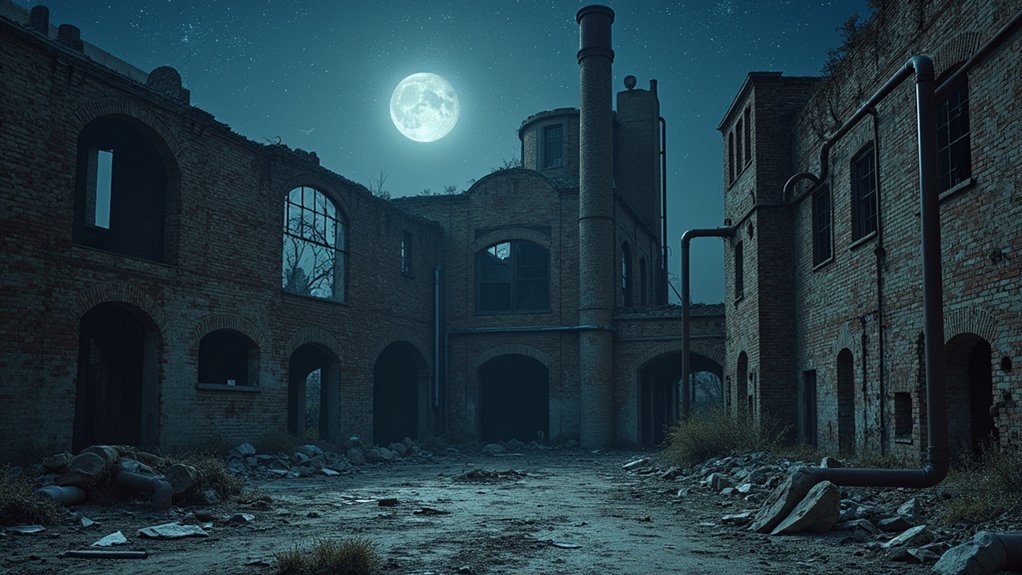The best abandoned spots for stargazing photography include ghost towns with perfect dark skies, abandoned railway stations offering compelling Milky Way foregrounds, forgotten mining structures creating vertical elements for star trails, deserted farm buildings providing accessible rural settings, and derelict industrial sites showcasing unique textures under moonlight. You’ll find these locations combine historical intrigue with minimal light pollution while offering dramatic compositional elements. Discover how these forgotten places transform into celestial gateways after sunset.
Ghost Towns: Perfect Dark Sky Havens Away From Light Pollution

While city dwellers struggle to see more than a handful of stars, ghost towns offer photographers an unparalleled window to the cosmos. These abandoned places sit far from urban centers, creating natural dark sky sanctuaries where the Milky Way bursts forth in breathtaking clarity.
You’ll find that ghost town locations like Two Guns, Arizona provide more than just absence of light pollution—they offer compelling historical ruins that serve as ideal foreground elements in your compositions. Without nearby habitation, these forgotten settlements eliminate ambient light interference that typically washes out celestial details.
Places such as Kayaköy, Turkey combine rich history with prime stargazing conditions, allowing you to capture both architectural remnants and stellar phenomena in one frame.
You’ll experience not just superior night sky viewing but also the haunting atmosphere that makes these locations truly special.
Abandoned Railway Stations: Compelling Foregrounds For Milky Way Shots
As trains ceased their journeys through once-bustling stations, a new opportunity emerged for astrophotographers seeking distinctive foreground elements. These abandoned structures offer perfect compositions for your night photography adventures.
You’ll find these railway relics often situated far from urban centers, providing naturally dark skies ideal for capturing the Milky Way’s brilliance. Many are even located near National Park boundaries, combining historical architecture with protected dark sky zones.
| Benefits | Photography Techniques |
|---|---|
| Minimal light pollution | Light painting the tracks |
| Architectural framing | Long exposures with stars |
| Historical storytelling | Silhouette compositions |
| Open viewing angles | Focus stacking methods |
| Remote, quiet locations | Star trail sequences |
Always assess structural safety before venturing into abandoned stations—your perfect shot isn’t worth risking injury.
Forgotten Mining Structures: Vertical Elements For Star Trail Photography

Towering above the arid landscape, forgotten mining structures create dramatic vertical silhouettes against the rotating cosmos. These abandoned buildings offer perfect compositional elements when you’re capturing star trails, adding depth and historical context to your night photography.
Position your camera to frame old mine shafts and headframes against the swirling stars—the contrast between decaying human industry and celestial movement tells a compelling visual story. Locations like Colorado’s silver mines or Nevada’s ghost towns provide ideal settings where industrial history meets astronomy.
Try light painting these structures with minimal illumination to highlight their architectural details while maintaining focus on the star trails above.
The juxtaposition of rugged, static frameworks against dynamic star movements creates photographs that are both technically impressive and emotionally evocative, transforming forgotten places into gateways to the universe.
Deserted Farm Buildings: Accessible Rural Settings For Nightscapes
Unlike their industrial counterparts, abandoned farmhouses and barns offer photographers a more accessible entry into night photography against starlit backdrops.
You’ll find these rural settings conveniently reached via country roads, yet far enough from cities to escape light pollution that obscures celestial views.
Deserted farm buildings provide compelling compositional elements for your stargazing photography, creating striking contrasts between weathered structures and the infinite cosmos above.
Their agricultural heritage adds narrative depth to your images that purely natural landscapes often lack.
Try light painting techniques to highlight architectural details while capturing the stars.
A strategic flashlight beam can reveal textural elements of dilapidated wooden barns or stone silos, while your long exposure captures the brilliant tapestry of stars wheeling overhead—blending Earth’s past with the universe’s timeless presence.
Derelict Industrial Sites: Unique Textures Under Moonlight

Scattered across forgotten landscapes, abandoned factories and warehouses transform into otherworldly photography venues when darkness falls. These derelict industrial sites offer remarkable foreground elements that contrast beautifully with star-filled skies, creating depth in your long exposure shots.
What makes these locations special is how moonlight interacts with rusted machinery and weathered concrete, revealing textures invisible during daylight hours. Their remote locations, often away from light pollution, provide clear views for astrophotography while preserving elements of ancient history through their structural remains.
Before heading out, research GPS coordinates of accessible sites like old mines or rail yards. Their iconic structures naturally frame celestial events, allowing you to capture both industrial decay and cosmic beauty in one compelling image—telling stories of human endeavor beneath the timeless canopy of stars.
Frequently Asked Questions
How to Photograph Abandoned Places?
Scout locations during daylight, use wide-angle lenses, bring a sturdy tripod, and capture during golden hour. Don’t forget permission where needed—you’ll want to respect property rights while documenting these hauntingly beautiful spaces.
What Is Photography of Abandoned Places Called?
Photography of abandoned places is primarily called “ruin photography” or “ruinism.” You’ll find photographers using these terms when they’re capturing decaying structures, derelict buildings, and forgotten spaces that evoke nostalgia and historical significance.
How to Do Night City Photography?
For night city photography, you’ll need a tripod, slow shutter speeds (5-30 seconds), and a wide aperture (f/2.8-f/5.6). Include foreground elements and manage light sources to avoid overexposure in your urban nightscapes.
In Summary
You’ve now got five incredible abandoned locations to elevate your night sky photography. Whether you’re capturing star trails above mining headframes or the Milky Way behind a forgotten railway station, these spots offer both dramatic foregrounds and minimal light pollution. Remember to prioritize safety, pack your tripod and headlamp, and always respect these historic sites. Now get out there and create stunning starscapes no one else has captured!





Leave a Reply